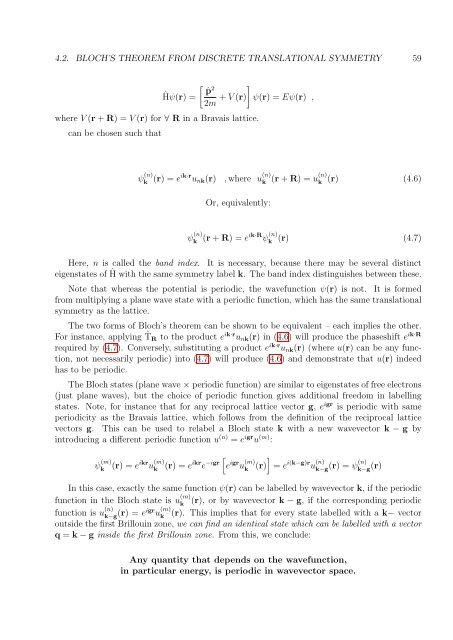Set of supplementary notes.
Set of supplementary notes.
Set of supplementary notes.
You also want an ePaper? Increase the reach of your titles
YUMPU automatically turns print PDFs into web optimized ePapers that Google loves.
4.2. BLOCH’S THEOREM FROM DISCRETE TRANSLATIONAL SYMMETRY 59<br />
Ĥψ(r) =<br />
[ ˆp<br />
2<br />
2m + V (r) ]<br />
ψ(r) = Eψ(r) ,<br />
where V (r + R) = V (r) for ∀ R in a Bravais lattice.<br />
can be chosen such that<br />
ψ (n)<br />
k (r) = eik·r u nk (r) , where u (n)<br />
k<br />
(r + R) = u(n)<br />
k<br />
(r) (4.6)<br />
Or, equivalently:<br />
ψ (n)<br />
k<br />
(r + R) = eik·R ψ (n) (r) (4.7)<br />
k<br />
Here, n is called the band index. It is necessary, because there may be several distinct<br />
eigenstates <strong>of</strong> Ĥ with the same symmetry label k. The band index distinguishes between these.<br />
Note that whereas the potential is periodic, the wavefunction ψ(r) is not. It is formed<br />
from multiplying a plane wave state with a periodic function, which has the same translational<br />
symmetry as the lattice.<br />
The two forms <strong>of</strong> Bloch’s theorem can be shown to be equivalent – each implies the other.<br />
For instance, applying ˆT R to the product e ik·r u nk (r) in (4.6) will produce the phaseshift e ik·R<br />
required by (4.7). Conversely, substituting a product e ik·r u nk (r) (where u(r) can be any function,<br />
not necessarily periodic) into (4.7) will produce (4.6) and demonstrate that u(r) indeed<br />
has to be periodic.<br />
The Bloch states (plane wave × periodic function) are similar to eigenstates <strong>of</strong> free electrons<br />
(just plane waves), but the choice <strong>of</strong> periodic function gives additional freedom in labelling<br />
states. Note, for instance that for any reciprocal lattice vector g, e igr is periodic with same<br />
periodicity as the Bravais lattice, which follows from the definition <strong>of</strong> the reciprocal lattice<br />
vectors g. This can be used to relabel a Bloch state k with a new wavevector k − g by<br />
introducing a different periodic function u (n) = e igr u (m) :<br />
[ ]<br />
ψ (m)<br />
k<br />
(r) = eikr u (m)<br />
k (r) = eikr e −igr e igr u (m)<br />
k (r) = e i(k−g)r u (n)<br />
k−g<br />
(r) = ψ(n)<br />
k−g (r)<br />
In this case, exactly the same function ψ(r) can be labelled by wavevector k, if the periodic<br />
function in the Bloch state is u (m)<br />
k<br />
(r), or by wavevector k − g, if the corresponding periodic<br />
function is u (n)<br />
k−g (r) = eigr u (m)<br />
k<br />
(r). This implies that for every state labelled with a k− vector<br />
outside the first Brillouin zone, we can find an identical state which can be labelled with a vector<br />
q = k − g inside the first Brillouin zone. From this, we conclude:<br />
Any quantity that depends on the wavefunction,<br />
in particular energy, is periodic in wavevector space.








